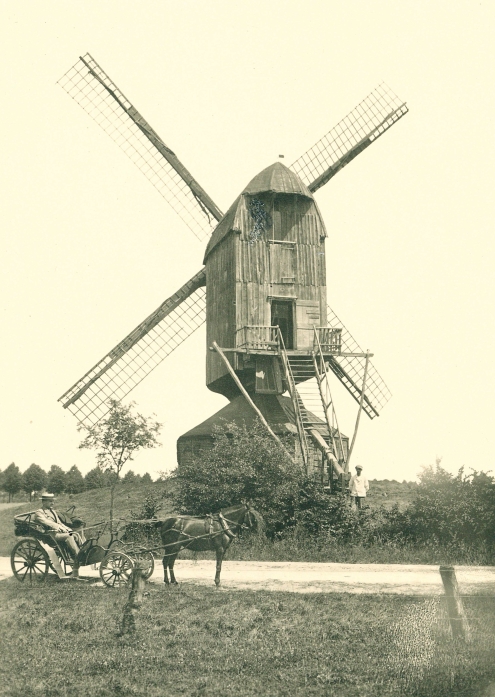Photo of the month - April 2023
The Sporker Bockwindmühle from 1818
The Bocholt City Archive commemorates the Bockwindmühle in the district of Spork with its historical "Photo of the Month".
"The Bockwindmühle now stands there, in Spork probably over a hundred years [...] Worn down by the weather and the wind, it came to an end quickly". These verses from the pen of Heinrich van der Beck are taken from a three-verse poem describing the condition and nature of the Spork Bockwindmühle, located at the Gries estate, in the 1930s. The second rhyme in particular reads like a gloomy prediction: on 12 April 1943, this local landmark was indeed destroyed by a violent spring storm.
Built in 1818 by Wilhelm von Hamelberg
The Bockwindmühle was an example of a typical German windmill. In contrast to the characteristically Dutch tower windmills, where only the roof bonnet can be rotated, the entire body of the windmill, including the free-floating staircase, moves in the case of the column windmills. The base, the so-called trestle, forms the rotating element. The Sporker Bockwindmühle was the only one of its kind in the whole of Westphalia until its demise through the forces of nature.
It was built in 1818 by Lieutenant Colonel Friedrich Wilhelm von Hamelberg, who lived on the Heidefeld estate, to save the local farmers the long distances to the windmills in Suderwick and Bocholt. The miller Arnold Radstaak leased the flour mill in 1842 before his son Wilhelm bought it from the Hamelberg heirs in 1871. In 1900, the property finally passed to the Essing family for 7,500 marks.
60 sacks of grain a day
The maximum output of the grinding mill was about 60 sacks of grain a day in continuous operation. By 1931, the wind and weather had already taken their toll on the mill. Twice it was struck by lightning and severely damaged. The owner therefore considered demolishing the windmill. However, this was prevented by an initiative of the mayor Bernhard Blume, who had it listed as a historical monument. With the financial support of the Bocholt Heritage Society, which was unable to prevent the demolition of the Bocholt windmill in 1930, the Spork mill was restored in 1941.
After its destruction in 1943 by a storm, it was not rebuilt. However, the memory of the Bockwindmühle remained alive through a representation in the coat of arms of the Liedern-Werth district and through a crossing stone in the vault of St. George's Church.




